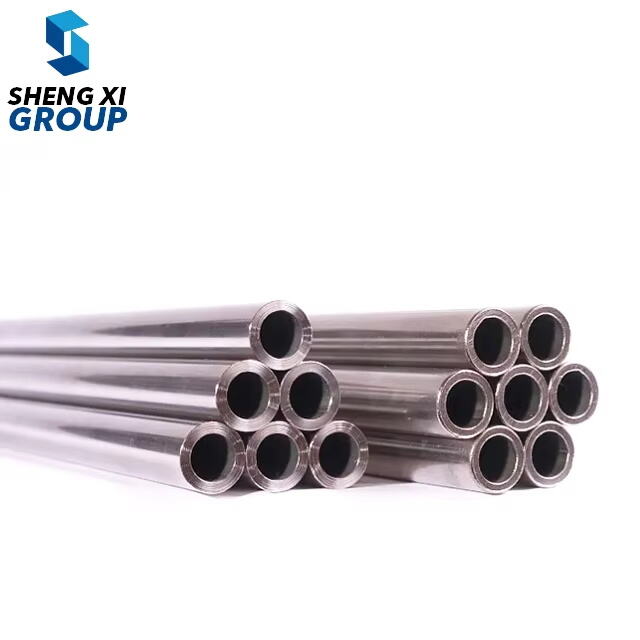Key Strength Metrics of Alloy Steel
Tensile Strength: Measuring Maximum Load Capacity
Tensile strength tells us how well alloy steel holds up when stretched or pulled apart, basically showing if it will snap under pressure. Most alloy steels have tensile strengths above 600 MPa on average, which makes them pretty tough stuff for all sorts of tough jobs. This property matters a lot in fields like building big structures and making airplanes, where parts need to stay intact even when subjected to massive pulling forces. Think about suspension bridges holding up entire cities or airplane wings dealing with extreme stress during flight. Testing for tensile strength follows guidelines set out in standards such as ASTM E8. These tests make sure materials can actually handle those maximum loads they're supposed to carry without giving way unexpectedly.
Yield Strength: Understanding Elastic Limits
The yield strength of materials marks when they start to deform permanently instead of returning to their original shape after stress. Alloy steels generally have yield strengths around 250 MPa or higher, making them pretty reliable for building safe structures. When engineers design buildings or bridges, they look at these numbers to figure out how much weight something can take before it starts to bend or break. Industry insiders know this matters a lot in places like offshore drilling platforms and industrial chemical facilities. A single failure there could cause massive problems for workers and equipment alike. That's why so many construction teams pay close attention to these values during planning stages. After all, nobody wants surprises when dealing with heavy loads and expensive infrastructure projects.
Impact Strength: Resistance to Sudden Forces
The impact strength of alloy steel basically tells us how well it can stand up against sudden shocks and impacts, which makes it really important for things built to last in tough environments. When engineers run tests like Charpy or Izod impact tests, they get those average numbers that show just how much force the steel can take before breaking apart. We've seen plenty of real world examples where materials failed because they didn't have enough impact strength, leading to major accidents and expensive repairs down the line. That's why specs matter so much in building structures and machinery. Standards organizations created guidelines like ASTM E23 specifically for these tests so manufacturers know exactly what their materials need to do. Following these standards helps ensure different types of alloy steels can actually perform under stress without giving way unexpectedly during operation.
Hardness and Toughness in Alloy Steel
Wear Resistance Through Surface Hardness
The hardness of a material's surface matters a lot for alloy steels because it helps resist wear and abrasion, which becomes really important when parts are constantly rubbing against each other in heavy duty situations. Most people measure surface hardness on what's called the Rockwell scale, and good quality alloy steel usually scores above 60 on that scale. Tool makers and manufacturers who run big machines rely heavily on this property since their operations can lose thousands when components wear out too fast. Research shows there's definitely a link between harder surfaces and longer lasting parts, meaning fewer replacements needed over time. This actually makes a real difference in factories where machines work non stop, cutting down both repair bills and downtime while extending how long equipment stays productive before needing replacement.
Toughness: Balancing Strength and Fracture Resistance
The toughness of alloy steel matters a lot because it shows how well the metal holds up when stretched (ductility) versus when pushed hard (strength). For things like oil pipelines or pressure tanks, this balance becomes really important since the material needs to handle intense pressure while also resisting damage from sudden impacts. Engineers run tests like the Charpy impact test to see how metals react when hit hard, which helps determine if they'll work properly in tough situations. Metal experts have noticed something interesting: changing what elements go into the alloy mix actually affects how tough the final product turns out. Some alloys might be great for underwater structures but struggle in freezing temperatures, while others excel in high heat environments. By tweaking these compositions just right, manufacturers create materials that fit exactly what's needed for whatever job comes their way.
The Role of Carbon Content in Hardness
The amount of carbon present really affects how hard and what kind of mechanical properties alloy steels have. More carbon usually means harder steel, which makes these materials great choices when building tools or machine components that need to stand up to tough conditions. Take cutting tools for example those made with just the right carbon levels perform much better and last longer, something manufacturers can't afford to compromise on since their machines depend on it. Studies indicate carbon content plays a role in how heat treatments work too. When metalworkers tweak these heating and cooling cycles properly, they get better hardness results from their alloy steels. This matters because stronger, more wear resistant materials mean fewer breakdowns across all sorts of manufacturing operations.
Elasticity and Ductility: Flexibility Under Stress
Elastic Modulus in Alloy Steel Applications
Elastic modulus plays a really important role when working with alloy steels, generally falling somewhere around 200 to 210 gigapascals. Basically, it tells us how much a material can bend or stretch before breaking, and then bounce back to its original form after we take away whatever force was applied. Engineers rely heavily on this property when designing all sorts of structures because nobody wants their bridge or building to sag or warp unexpectedly. Finding the right mix between being flexible enough to handle stress but still rigid enough to hold shape is what makes construction projects successful in the long run. Studies from various research groups indicate that getting the elastic properties just right cuts down on structural failures significantly. That's why choosing the correct type of alloy steel matters so much for anything built to last decades rather than years.
Ductility Measurements for Formability
Ductility basically tells us how much an alloy steel can stretch or twist before it snaps, something we measure by looking at elongation percentages and how much area gets reduced during tensile tests. When materials have good ductility, they make life easier in manufacturing shops. Think about forming operations or welding jobs where metal needs to bend and reshape without cracking apart. Without sufficient flexibility, these processes just won't work right. For making complicated parts and building structures, this ability to deform matters a lot because it keeps production moving smoothly instead of grinding to a halt. Most industries have established standards for what level of ductility different alloys should have. These benchmarks help engineers pick the right materials for their projects whether they're working on car frames or airplane parts, both situations where materials need to handle stress and change shape when needed.
Stress-Strain Relationships Explained
Knowing how stress relates to strain is essential when looking at how alloy steel behaves when forces are applied. Stress-strain curves serve as basic tools that show where materials start to yield and eventually fail, giving engineers a clear picture of performance across various situations. These analyses help forecast how long materials will last and how they'll hold up in everything from building supports to parts inside big machines. When engineers study these relationships closely, they can pick better materials that stand up to wear and tear while keeping things safe. Looking at graphs makes it easier to grasp concepts like elastic limits and what happens during plastic deformation stages something really important when choosing the right materials for specific jobs.
Factors Affecting Alloy Steel Mechanical Properties
Alloying Elements: Chromium, Nickel, and Molybdenum Effects
Alloy steel gets its special qualities from adding things like chromium, nickel, and molybdenum into the mix. These additions make the steel stronger, help it resist rust better, and give it more toughness overall. Take chromium for example it really steps up the game when it comes to fighting corrosion. Nickel makes the steel bend without breaking, which is good for parts that need to flex. And then there's molybdenum, which helps the steel stay tough even at high temperatures. When manufacturers get the right mix of these elements, they see some pretty impressive results that match what the standards require. Most shops know this from experience rather than just reading papers about it. What makes alloy steel so useful in so many places isn't just about being strong, but finding that sweet spot where all these properties work together nicely.
Heat Treatment Processes and Their Impact
Heat treatment is really important when it comes to getting the best mechanical properties out of alloy steel. When we talk about things like annealing, quenching, and tempering, what we're actually doing is changing how the metal's internal structure looks at a microscopic level. This affects things people care about - hardness, strength, and how much the material can stretch before breaking. Take quenching followed by tempering for instance. This process basically means heating up the steel until it glows red hot and then dunking it into oil or water to cool it down fast. The result? Steel that's both strong and tough enough for tough jobs. From what we've seen in actual factories, small changes in how long we heat the metal or what temperature we use make a big difference in final product quality. Engineers working on real projects need to get their hands dirty with these treatments because different applications require different results. A bridge component needs totally different properties compared to something used inside an engine block after all.
Manufacturing Processes: Forging vs Casting
How alloy steel is made, whether by forging or casting methods, has a major impact on what kind of microstructure forms inside it and how strong it ultimately becomes. Forging tends to be the go to method when making parts that need serious strength and resistance to breaking under stress because the process actually squishes and reorganizes the metal's internal grain pattern. Casting offers something different though it lets manufacturers create really complicated shapes that would be tough or impossible with other techniques. But there's a trade off here too since castings usually end up with less consistent internal structures which might mean they aren't as tough or flexible as their forged counterparts. Looking at test results from various labs over the years shows pretty clearly that forged alloy steel generally performs better mechanically thanks to those improved grain structures developed during forging operations. Most engineers we talk to point towards forging whenever structural integrity matters most, especially in aerospace or heavy machinery components. Still, nobody can deny the value casting brings to table when dealing with intricate designs that require lots of detail work.
Frequently Asked Questions
What industries commonly use alloy steel?
Alloy steel is widely used in construction, automotive, and aerospace industries due to its enhanced structural integrity and performance.
Why is alloy steel preferred over carbon steel?
Alloy steel is preferred for its superior strength, toughness, and corrosion resistance, outperforming carbon steel by up to 30% in various tests.
How does tensile strength affect alloy steel applications?
Tensile strength is crucial in industries like construction and aerospace, where materials must withstand significant tension without failing.
What are the key alloying elements in alloy steel?
Chromium, nickel, and molybdenum are key elements that enhance alloy steel's strength, corrosion resistance, and toughness.
What is the impact of heat treatment on alloy steel?
Heat treatment processes like annealing, quenching, and tempering optimize alloy steel's mechanical properties, adjusting its hardness, strength, and ductility.


